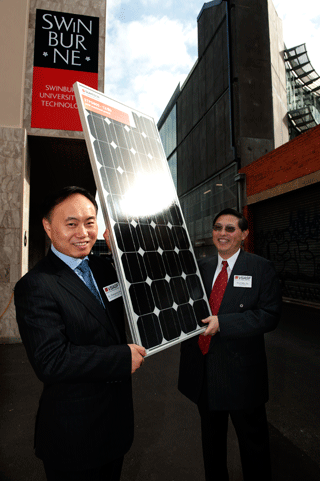
|
Published: 20 February 2012
‘Shazam nano nano’: the world’s most efficient solar cells
In a boon for the local solar industry, a team of researchers from Swinburne University of Technology and China’s Suntech Power Holdings - the world’s largest producer of silicon solar modules - have developed broadband nanoplasmonic solar cells claimed to be the most efficient to date.
In a paper published in the journal NANO Letters, the researchers describe how they have manufactured thin film solar cells with an absolute efficiency of 8.1 per cent.
The research was conducted through the Victoria-Suntech Advanced Solar Facility (VSASF) at Swinburne, a $12 million program jointly funded by the Victorian Government, Swinburne and Suntech.
According to Swinburne’s Professor Min Gu, Director of the VSASF, thin film cells have attracted enormous research interest as a cheap alternative to the bulk crystalline silicon cells that currently dominate the market. However, the significantly reduced thickness of the silicon layer on thin film cells makes it more difficult for them to absorb sunlight.
‘Light trapping technology is of paramount importance to increase the performance of thin film solar cells and make them competitive with silicon cells,’ says Professor Gu.
‘One of the main potential applications of the technology will be to cover conventional glass, enabling buildings and skyscrapers to be powered entirely by sunlight.’
The VSASF group has been improving thin film cell efficiency by embedding gold and silver nanoparticles into the cells. This increases the wavelength range of the absorbed light, improving the conversion of photons into electrons.
In their most efficient cells yet, the researchers went one step further, using what are known as nucleated or ‘bumpy’ nanoparticles, creating what is termed a ‘broadband plasmonic effect’.
‘What we have found is that nanoparticles that have an uneven surface scatter light even further into a broadband wavelength range. This leads to greater absorption, and therefore improves the cell’s overall efficiency,’ says Dr Baohua Jia, Senior Research Fellow at Swinburne.
Professor Gu believes there is still considerable scope to improve the cells and transform the way the world sources energy.
‘We are on a rapid upwards trajectory with our research and development. With our current rate of progress we expect to achieve 10 per cent efficiency by mid 2012.
‘We are well on track to reach the VSASF’s target to develop solar cells that are twice as efficient and run at half the cost of those currently available.’
He says another advantage of the group’s approach is that nanoparticle integration is inexpensive and easy to upscale and therefore can easily be transferred to the production line.
‘We have been using Suntech solar cells from the outset, so it should be very straightforward to integrate the technology into mass manufacturing. We expect these cells to be commercially available by 2017.’
CSIRO has also been developing ‘printable’ thin film solar technology as part of the Victorian Organic Solar Cell Consortium, which has received funding from the Victorian Government Department of Primary Industries and the Australian Solar Institute .
Source: Swinburne University of Technology




